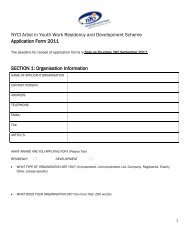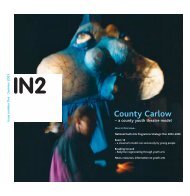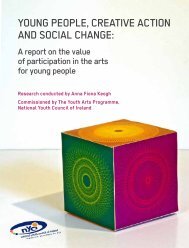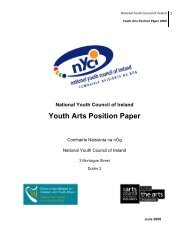DRAMA SPACES - Youth Arts Programme
DRAMA SPACES - Youth Arts Programme
DRAMA SPACES - Youth Arts Programme
You also want an ePaper? Increase the reach of your titles
YUMPU automatically turns print PDFs into web optimized ePapers that Google loves.
dramaspaces6 18/8/05 4:25 PM Page 27Furthering the work 1• During the same workshop, we further explored how we could use status to help us improvise, bymoving on to other interactive situations.• Ask for some volunteers and allow them to take a playing card.This ordinary playing card will denotethe status of the role they will take on in the scene. No one else should see it, so that neither theplayers nor the audience are aware of the status to be portrayed.Allow them to play out the followingsituations:• Doctor’s waiting room• Bus Queue• Bank Queue• Once each person has had an opportunity to play a part in the scene, freeze the scene. Invite theaudience to guess what status each player had.Furthering the work 2• Go back to the scenes done earlier and attach a new status to each partner.See how the status changesthe scene from how it was played before.Try reversing the status and see whether it changes the scene.• After the scenes, discuss if anyone said certain thing that allowed the scene to develop or continue.These are offers and by accepting them the other players are allowing the scene to develop. It is somethingyou want to encourage if you wish to continue using improvisation with a group. Not accepting anoffer is called ‘Blocking’, which causes a scene to stop or end.A Note of CautionIt is worth noting that if you are asking young people to take on a role, you need to create a distancebetween the young people and that role.The character created by someone participating in a drama workshop is called ‘a role’and when they are inthe world of this character they are ‘in role’. Being ‘in role’can be a valuable experience for a young person.At a time in their lives where they are ‘trying on’different personalities and attributes, being in role allowsthem an opportunity to escape from the role the group may have elected for them. However, this can leadto a young person creating a role that is close to his or her own personality. It can lead to a blurring of linesbetween the character and the young actor that may expose that person to bullying, teasing and gossip.Creating a clear distinction between the person and their role or character is called ‘distancing’. Creating anindependent character by asking the character the questions listed below will help. You could also move27






